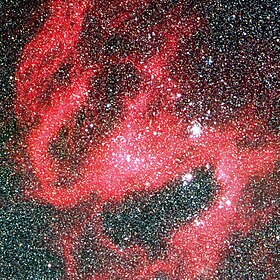| Observation data Epoch J2000 Equinox J2000 | |
|---|---|
| Constellation | Dorado |
| Right ascension | 05h 18m 14.3572s[1] |
| Declination | −69° 15′ 01.148″[1] |
| Apparent magnitude (V) | 8.6 – 11.5[2] |
| Characteristics | |
| Spectral type | B8/9eq – F0/5:Iae[3] |
| U−B color index | –0.98[4] |
| B−V color index | +0.11[4] |
| Variable type | S Doradus[2] |
| Astrometry | |
| Radial velocity (Rv) | +228[5] km/s |
| Proper motion (μ) | RA: 1.735[1] mas/yr Dec.: 0.280[1] mas/yr |
| Parallax (π) | 0.0073 ± 0.0371 mas[1] |
| Distance | 169,000 ly (51,800 pc) |
| Absolute magnitude (MV) | –7.6 (1965) –10.0 (1989)[6] |
| Details | |
| Mass | 24+16 −2[7] M☉ |
| 1989 (maximum) | |
| Radius | 380[8] R☉ |
| Luminosity | 910,000[6] L☉ |
| Surface gravity (log g) | 0.6[8] cgs |
| Temperature | 8,500[6] K |
| 1985 (minimum) | |
| Radius | 100[8] R☉ |
| Luminosity | 1,400,000[8] L☉ |
| Surface gravity (log g) | 1.6[8] cgs |
| Temperature | 20,000[8] K |
| 1965 (deep minimum) | |
| Luminosity | 2,000,000[6] L☉ |
| Temperature | 35,000[6] K |
| Other designations | |
| Database references | |
| SIMBAD | data |
S Doradus (also known as S Dor) is one of the brightest stars in the Large Magellanic Cloud (LMC), a satellite galaxy of the Milky Way, located roughly 160,000 light-years away. The star is a luminous blue variable, and one of the most luminous stars known, having a luminosity varying widely above and below 1,000,000 times the luminosity of the Sun, although it is too far away to be seen with the naked eye.
- ^ a b c d e Cite error: The named reference
dr2was invoked but never defined (see the help page). - ^ a b Cite error: The named reference
GCVSwas invoked but never defined (see the help page). - ^ Cite error: The named reference
mkwas invoked but never defined (see the help page). - ^ a b Cite error: The named reference
nicoletwas invoked but never defined (see the help page). - ^ Cite error: The named reference
rgcrvwas invoked but never defined (see the help page). - ^ a b c d e Cite error: The named reference
vangenderen2001was invoked but never defined (see the help page). - ^ Cite error: The named reference
lamers1998was invoked but never defined (see the help page). - ^ a b c d e f Cite error: The named reference
lamers1995was invoked but never defined (see the help page).
